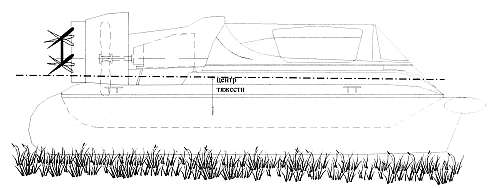Travel on water
- at a wave 0,4-0,5 m high and less than 10m long the craft is recommended to move along the wave in order to protect the airline and ventilator from water;
- at a wave higher than 0,5m it is necessary to lower the speed, hover keeping the air cushion and eliminating water getting into the ventilator and come onto calm water;
- the craft needs a long time to start from water so that the air given by the ventilator could force the water out of the bag skirt
Travel on snow and ice
- a peculiarity of travel on snow and ice is a long brake way of the craft (700 m long at the speed 70 km/h on ice). The brake way depends on the surface state, and direction and force of the wind
NB! Exploitation of the craft on ice surface with sharp ice ridges may result in damages of flexible protection.
Travel on hard ground – sand, asphalt, concrete, gravel
The craft is not meant on these surfaces for a long travel because it may lead to abrasive erosion of the ventilator blades and to a quick wear of the flexible skirt.
Travel on grass and swamps
- grass must be no higher than 0,5 m;
- proper bearing of the nose and aft to the ground surface should be provided at the start.
NB! The main factor of the best travel and max speed is the craft position horizontal to the surface of the motion!

Remember!
Due to the passengers' total weight, total weight of the cargo and its location inside the cabin (hull), the gravity centre changes, so it is important to mind the position of the horizontal rudders.
Position of horizontal rudders along different types of surface
| 1 | Travel on the hard and non-slippery ground (sand, asphalt, grass, etc.) |
 | ||
| 2 | Travel on water | Step I start from water Rudders up  |
Step II the exit of the nose onto the surface rudders down  |
Step III 'full air cushion' regime leveling of the craft  |
| 3 | Travel on ice | Leveling of the craft | ||







